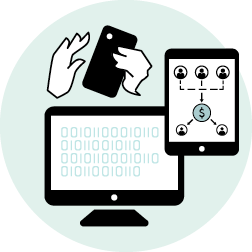Statistics vary from study to study, but it’s clear that a significant portion of Americans have a hard time making ends meet between paychecks.
According to a recent Salary Finance report, “Inside the Wallets of Working Americans,” almost one-third run out of money before their next paycheck. An ING Survey puts the number even higher, saying that 56% of American families find themselves out of money at the end of their pay period either occasionally or most of the time.
That kind of financial pressure causes a great deal of stress – more than relationships, careers, and health – 42% of the Salary Finance respondents said. And while that stress happens across all income levels, those who make less money and have smaller savings accounts are hit the hardest by the traditional one- or two-week pay cycle.
The solution? It’s a relatively simple one, backed by research: pay those who make less money more frequently. And luckily, technology can help employers do just that.
The Hard-to-Manage Stretch Between Paydays
While lack of financial management skills and overconsumption certainly contribute to the problem, that’s far from the whole story. The pandemic – a prime example of circumstances not under our control – has taught us that anyone can be one job loss away from financial disaster, particularly when unemployment lasts for months.
For example, medical crises – which can happen to anyone, including people who take care of their health – are the primary contributor to bankruptcy. A recent study found that two-thirds of all bankruptcies are tied to medical issues, either because of the high cost of healthcare or time out of work. Some 530,000 families turn to bankruptcy each year because of health issues and related bills, according to the research.
In these and other cases, people are forced to take lower-paying work or live on one paycheck rather than two. Income decreases and suddenly paying bills becomes a struggle. The stretch between paydays seems very long indeed. “In one sense, periodic paychecks are, by definition, drivers of income volatility. Every payday is an income spike,” an Aspen Institute study on payroll innovation points out. And many people aren’t skilled at managing those spikes, particularly when money is short.
One recent study found that retired couples who receive both of their monthly Social Security checks on the same day struggle to smooth their consumption and spending, more so than do couples who receive their checks at different times.
The effect was particularly strong for low-income households, the Institute says. “If a bill comes due days, or even hours, before a paycheck lands in a worker’s checking account, the result can be financially disastrous – leading to late fees, overdraft charges, payday loans, pawn shops, or other costly financial bridges.” The fees alone for bank overdrafts, late payments, and payday loans top $170 billion each year, according to the Financial Health Network, dragging those who can least afford it farther down a financial hole.
In effect, each payday brings with it a small, predictable financial crisis – a continuous cycle of pay, spend, fall short, and in too many cases, borrow (with high interest) to close the gap. But another study says the way to break the cycle is by paying those who earn low wages more often.
More Frequent Pay Smooths Out Peaks and Valleys
In The Timing of Pay, academics Christopher Parsons and Edward Van Wesep explored the optimal timing of pay to smooth out consumption. Their research found that workers who make less, and therefore have less of a savings buffer to help between paychecks, should be paid more frequently. Money coming in to match consumption (paying bills, buying food) removes the hard-to-manage income spike and reduces the need to turn to expensive temporary solutions such as payday lending.
While their study showed that payday loans and similar financial instruments can be beneficial when the loan amount is capped, it also cites other academic studies that document negative consequences for users of payday loans – a greater likelihood of declaring personal bankruptcy, paying bills late, and delaying medical care, for example. As Parsons and Wesep say, “Payday loans are an inferior substitute for more frequent pay.”
The Right Technology Eases the Way
Paying workers more frequently – even daily – may sound difficult and time-consuming to an employer. But that’s where technology comes into play: the right tool can make it easy for business owners to let employees select the pay frequency that beat meets their unique needs.
With such options, an employer can give employees instant access to their wages at any frequency, even at the end of every shift. Payments can be deposited to an employee’s debit card and verified with built-in identity confirmation so businesses are certain the right person is receiving the payout.
In addition to helping employees meet financial needs, offering frequent pay can attract new talent and retain employees, as well as improve performance and reduce absenteeism. According to the Aspen Institute study, more than one in four millennials value real-time pay even more than a raise. And a PwC study showed that half of those employees who worry about finances are less productive at work. So reduced stress can lead to better job performance.
Much of the debate over pay has centered on the amount people are paid and the structure of payments (salaried, hourly, and so on). The Parsons/Van Wesep study surfaced the issue of timing as a key element of financial health. It turns out that in this case, timing really is everything – or, at least, a factor worthy of more consideration by employers than they might have realized.
Want to learn more about MerchantE's EmployeePlus PayoutsSM? Check out this video!




